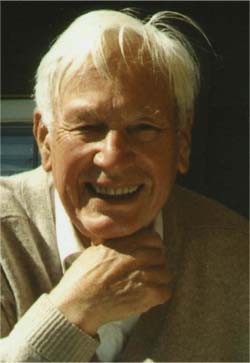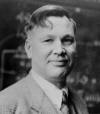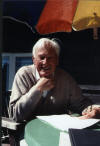 Maurice
Henry Lecorney Pryce was a theoretical physicist with very broad
interests who had a spectacular early career at Cambridge, Oxford and
Bristol and spent the second half of his life in the United States and
Canada. His father William had been a mathematics lecturer at the
University of Wales in Cardiff who moved to London to become a Patents
Examiner specialising in aeronautics. Maurice Pryce was born in
Croydon on 24 January 1913 but spent part of his childhood years with
his French mother in France where, according to a scientific colleague
in later years, he learned to speak French 'like a Normandy peasant'.
He is remembered as being fond of risky experiments such as using a
magneto to fire a small cannon loaded with home-made gunpowder.
Educated at the Royal Grammar School in Guildford he entered Trinity
College Cambridge in 1930, graduating in 1933 and continuing to do
research there initially with Sir Ralph Fowler and subsequently with
the Nobel laureate Max Born. He spent two years as a Commonwealth Fund
Fellow at Princeton University in 1935-7 before returning to Cambridge
as a Fellow of Trinity College.
Maurice
Henry Lecorney Pryce was a theoretical physicist with very broad
interests who had a spectacular early career at Cambridge, Oxford and
Bristol and spent the second half of his life in the United States and
Canada. His father William had been a mathematics lecturer at the
University of Wales in Cardiff who moved to London to become a Patents
Examiner specialising in aeronautics. Maurice Pryce was born in
Croydon on 24 January 1913 but spent part of his childhood years with
his French mother in France where, according to a scientific colleague
in later years, he learned to speak French 'like a Normandy peasant'.
He is remembered as being fond of risky experiments such as using a
magneto to fire a small cannon loaded with home-made gunpowder.
Educated at the Royal Grammar School in Guildford he entered Trinity
College Cambridge in 1930, graduating in 1933 and continuing to do
research there initially with Sir Ralph Fowler and subsequently with
the Nobel laureate Max Born. He spent two years as a Commonwealth Fund
Fellow at Princeton University in 1935-7 before returning to Cambridge
as a Fellow of Trinity College.
During this period in Cambridge he made outstanding
contributions to the so-called "New Field Theory'' proposed by Born
and Infeld. He also wrote an incisive paper demolishing the then
fashionable idea that light quanta might consist of pairs of
neutrinos. Paul Dirac, then one of the most influential theoretical
physicists, was so impressed (which was a very rare occurrence) that
he spontaneously offered to communicate the work to The Royal Society.
Maurice Pryce later remarked that this was the high-point of his
scientific life.
 In 1939 he was appointed to a Readership in
Theoretical Physics at Liverpool University, and married Margarete (Gritli)
Born. At the advent of war he joined the team working on radar at the
Admiralty Signal Establishment, and 1944 transferred to the Joint
Atomic Energy Project in Montreal. In 1945 he returned to his
fellowship at Trinity College, Cambridge, and a university
lectureship, but was soon invited to become Wykeham Professor of
Physics at Oxford, a chair which had recently been earmarked for a
theoretical physicist after the long tenure of Sir John Townsend. It
was a bold appointment for someone aged only 32; he looked so much
younger than his years that he was once famously challenged by the
Proctors' men while drinking in the King's Arms, a favourite meeting
place for Oxford physicists. He was mistaken for one of the
undergraduates, who at that time were forbidden by the University
authorities to enter public houses.
At Oxford he rapidly acquired a large group of
research students, many returning from war service, several of whom
were to become very distinguished in their fields. His interests and
knowledge spread across many branches of physics, and students were
put to work on widely ranging topics stretching from field theory, the
nuclear shell model, liquid helium, to solid state physics. Maurice
Pryce became most directly involved in interpreting the magnetic
properties of atoms which were being studied in great detail through
the paramagnetic resonance techniques by Brebis Bleaney and his
colleagues in the Clarendon Laboratory. Almost half his published work
relates to this area where he elucidated in detail the interaction
between the magnetic electrons and the lattice (the crystal field),
the effective lattice dynamics (the Jahn-Teller effect) and
interaction with the nucleus (hyperfine structure). He also added
considerably to the understanding of the magnetic properties of atoms
in the actinide series, including the newly discovered transuranics.
During his time in Oxford he took sabbatical leave to spend a year as
Visiting Professor at Princeton. On his return he acted as the
part-time head of the theoretical physics division at the nearby
Atomic Energy Research Establishment at Harwell, where he replaced the
previous head, Klaus Fuchs, who was arrested in 1950 and convicted on
a charge of spying. In 1951 Maurice Pryce was elected a Fellow of the
Royal Society. 
In spite of the successful scientific enterprise
which he was leading he became frustrated by the constraints of his
position and in particular by the autocratic management of Lord
Cherwell who, as head of the Clarendon Laboratory, controlled the
budget and the appointments: this was before the creation of a
separate department of theoretical physics. So in 1954 he accepted an
invitation to succeed Nevill Mott as Henry Overton Wills Professor of
Physics at the University of Bristol. With greater administrative
duties as head of the department he had less time to develop his
research group but he continued with the subjects that he had begun at
Oxford. His first marriage had broken down, and he married Freda
Kinsey in 1961. He then found a financially advantageous offer made by
the University of Southern California very tempting, and he moved
there in 1964 with the promise of resources to build up, essentially
from scratch, a first class physics department. The reality turned out
to be less attractive than he had hoped and he moved again to a chair
at the University of British Columbia in Vancouver in 1968 where he
was to remain until his death on 24 July 2003 at the age of 90.
During these later years Maurice Pryce had
relatively few research students and close collaborators and published
rather little. His main contributions were in the quite different
field of astrophysics although others on molecular photoionisation and
on the properties of the hydroxyl radical continued to display his
versatility and his wide understanding of physics. This knowledge was
greatly valued by his colleagues who would rely on a critical
appraisal of their work and its interpretation. But he did not suffer
fools gladly and was a harsh critic; in a seminar he could devastate
the speaker and embarrass the audience with his acerbic comments.
He also continued his interest in atomic energy
derived from his wartime work and was latterly a member of the
Technical Advisory Committee to the Atomic Energy of Canada Limited
with a particular interest on nuclear fuel waste management. Some of
his last work related to the questions of the safety of deposit of
radioactive materials in geological structures.
Maurice Pryce through much of his life was a keen
walker and camper and, when he was younger, dinghy sailor. He was a
competent pianist and liked to relax by playing classical music,
mainly Bach and Mozart. He was a good cook, which stood him in good
stead when entertaining friends and family after his second wife died
in 1989. He inherited from his father a love and knowledge of
gardening, which he passed on to all four of his children.
He always kept a boyish liking for silly games,
from elaborate sand castles on the beach to noisy card games on the
living room floor. Until ill health stopped him, he was a skilful
Scrabble player. He created a family tradition, perhaps characteristic
of his personal philosophy, of Collaborative Scrabble -- the main aim
is, within the rules, to maximise the overall score rather than to
beat the other players.
The mathematical gene has also passed on to his son
John, well known in his field of mathematical software
engineering; and to John's son Nathaniel, a professional software
engineer.
The last four years of his life were spent in the
University Hospital in Vancouver, incapacitated by
osteoporosis-induced bone fracture and subsequent infection. During
this period his mind was unaffected, and he bore immobility and
frequent pain with patience, courage and a sense of humour. He
remained in exemplary good spirits and was visited daily by a close
friend of long standing, Eileen Goldberg, the widow of a South African
lawyer who had been active in the fight against apartheid.
He is survived by his son John and three daughters
Sylvia, Lois and Suki, all from his first marriage.
Roger Elliot
John Sanders
|

